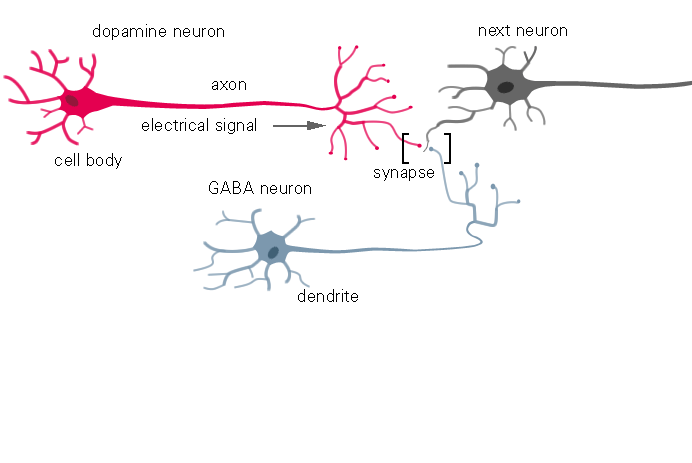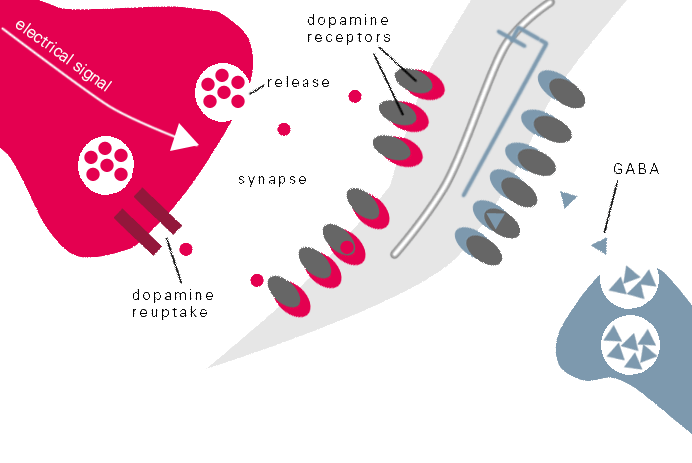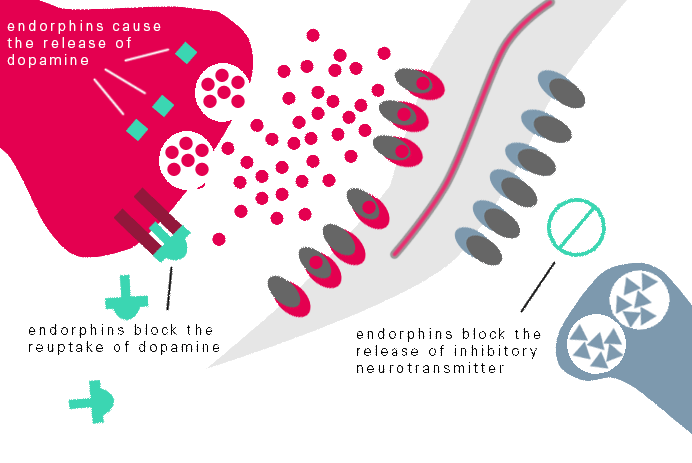the theory behind behavioral addiction
We feel good when neurons in the reward pathway release a neurotransmitter, called dopamine, into the nucleus accumbens and other brain areas.
Neurons in the reward pathway communicate with each other by sending electrical signals down their axons. The signal is passed to the next neuron across a small gap called the synapse. (See figure 2: diagram of the synapse)


figure 2: diagram of the synapse
When Dopamine is released into the synapse and crosses to the next neuron and binds to receptors, we feel a burst of pleasure. Excess dopamine is returned to the sending cell through a reuptake gateway. Other nerve cells release GABA, an inhibitory neurotransmitter that works to prevent the receptor nerve from being over stimulated. (See figure 3: an example of a healthy reward system)


figure 3: an example of a healthy reward system
Behavioral addiction sets in when endorphins increase the amount of dopamine in the synapse, heightening the feeling of pleasure, while at the same time endorphins block the reuptake of the dopamine, while at the same time endorphins block the release of the inhibitory neurotransmitter. Under such conditions the individual never feels a sense of satisfaction and the individual has to act out the behavioral addiction to a greater degree to feel the same degree of satisfaction. (See figure 4: an example of a faulty reward system)


figure 4: an example of a faulty reward system
automorphophilia as a behavioral addiction
Transsexualism as a phenomenon meets all the diagnosic characterists of a behavioral addiction.
Automorphophilia is the love of oneself engaged in a gender transition.
Automorphophilic behavioral addiction, the underlying cause of transsexualism, works in the same manner as sex addiction, Internet addiction or gambling addiction, and is caused by a faulty reward system in the human brain. Dr. Ray Blanchard of the CAMH coined the term, autogynephilia, to denote a male's paraphilic tendency to be sexually aroused by the thought or image of himself as a woman. He derived the term from its Greek roots, love of oneself as a woman (Blanchard, 1991, 2005), and later, he expanded the term to denote “a male’s paraphilic tendency to be sexually aroused by the thought or image of himself as a woman and refers to the full range of erotically arousing cross-gender behaviors and fantasies” (1991, p. 235). The definition is not limited to male-to-female transsexuals. Auto-eroticism exists in non-transsexuals as well, including cross-dressers with transvestic fetishism or transgendered natal males who do not identify as female on a persistent basis.
However, automorphophilia is much broader than autogynephilia (e.g., the thought that produces sexual arousal). Automorphophilia is the euphoria and exhileration as a result from the thoughts surrounding gender transition, which satisfy the diagnostic characterists of a behavioral addiction. [Click here to read the diagnostic characteristics of behavioral addictions]. An individual with an affected automorphophilic addiction disorder engages in thoughts with ever increasing intesity surrounding gender transition to get the same level of satisfaction.
the life cycle of automorphophilic behavioral addiction
Automorphophilia as a behavioral addiction in males has a predictable lifecycle, including five distinct phases. Each phase is marked by the person's sex drive and proximity to a major invasive surgical procedure, in the case of a male affecting the testosterone level, like a GRS procedure or similar procedure that protracts the testes.
Phase 1, Contraction, of the disorder begins as the person sexually develops, either at age 5 or at age 11 or thereabouts. At age 18 months, the infant has a gender identity that is immutable. Blanchard believes autogynephilia sets in due to a failure in the male child to fully externalize the female love object as the toddler develops a sexual identity (e.g., what turns you on). In any event the automorphophilic seeds are firmly planted. The child will either develop to be a cross-dresser or transsexual or she-male or a man with sexual interest in transvestites, transsexuals or she-males or some combination as sexual disorders rarely operate in isolation.
Phase 2, Affirmation, of the disorder begins as the person seizes on the consideration of a gender transition, involving a GRS procedure or similar feminizing procedure where the testes are protracted. (The phase may also begin when the person simply commits to undergo hormone replacement therapy. This is referred to a partial automorphophilia.) A person suffering from an affected automorphophilic addiction disorder—phase 2 will begin to experience obsessive compulsive thoughts. A number of these thoughts may revolve around a GRS procedure or similar feminizing procedure. The person may in fact have a history of obsessive compulsive thoughts due to other ancillary mental disorders. The compulsive obsessive thoughts, themselves, may or may not cause sexual arousal. However, the person, who has an affected automorphophilic disorder, can revisit automorphophilic thoughts at all phases of the disorder to bring about sexual arousal. In phase 2, automorphophilia moves beyond a sexual disorder and takes the characteristics of a behavioral addiction.
Phase 3, Escalation, of an automorphophilic disorder in males sets in during the period leading up to major invasive feminizing procedure, affecting the testosterone level, like a GRS procedure. By phase 3 the disorder firmly takes on the diagnostic characterists of a behavioral addiction. [Click here to read the diagnostic characteristics of behavioral addictions]
A person, who suffers from an automorphophilic addiction—phase 3, produces high amounts of endorphins in the pituitary gland of the brain that in turn produce high levels of dopamine—the chemical in the brain that affects the reward system—in the synapses. In fact the pituitary gland in the human brain typically produces endorphins during orgasm or similar sexual stimulus. The consideration of a gender transition qualifies as a sexual stimulus.
As dopamine is the gasoline of the reward system, the brain's own inhibitory system acts as the brake, stabilizing mood. When the person's inhibitory system, which is attenuated by the chemical, gamma aminobutyric acid (GABA), fails to function correctly, the brains never feels a sense of satisfaction. Thus, the endorphins of the person, who has an affected automorphophilic addiction disorder—phase 3, acts on the GABA as well, suppressing it. In effect the endorphins shut down the GABA, causing a fault in this critical function.
As the brain rewards the practice of automorphophilia it does so like any other behavioral addiction. The unusually high levels of dopamine coupled with the throttling of the GABA cause euphoria. A person, who suffers from an affected automorphophilic addiction disorder—phase 3, will typically report some degree of euphoria. In fact as the person takes steps in their respective gender transition, each one seems the correct one.
A person, who suffers from an affected automorphophilic addiction disorder—phase 3 and who also possesses a sex drive, will invoke masturbation thoughts that are not indigenous to a member of the opposite sex. For example, natal females do not masturbate to the thought of developing breasts and switching sexes or similar rituals of becoming female. In fact 99% of natal females are not interested in transsexual topics at all. Yet, typically the afflicted individual is utterly incapable of recognizing his distinct sexual practices are not of the norm. In the case where the afflicted individual is, he evades the issue. In the absence of a sex drive, the person, who finds it exciting to live as a member of the opposite sex, is still producing endorphins and in turn the endorphins continue to act on the synapse in the same manner.
A person, who has an affected automorphophilic addiction disorder—phase 3 may report his life "improving". He may even report that his life has never been better. Generally, a person, who suffers from an affected automorphophilic addiction disorder—phase 3, is not productive at work. The person is typically incapable of focusing on matters outside of his gender transition—even the mundane.
A person, who suffers from an affected automorphophilic addiction disorder—phase 3, will entertain over valued thoughts. The person may believe, for example, that their sex or gender transition doesn't really matter on the job. The person may believe that they are more attractive as a member of the opposite sex and are really meant to be a member of the opposite sex. The person may at age 40 or thereabouts, pose the question to himself, "why not spend the second half of my life as a member of the opposite sex?" which is an impossibility.
In addition to euphoria and over valued thoughts, a person, who has a severe degree of an affected automorphophilic addiction disorder—phase 3, will experience high levels of energy. The person may believe he is more mentally acute as a member of the opposite sex. The person may also subscribe to thoughts of grandeur; for example the belief that his life story is news worthy and should be published as a book and sold nationwide. In fact the person may publish a book only to see the stock of inventory be unsold and written off.
The person may also experience erratic mood swings and irritability. If the person is undergoing hormone replacement therapy, the synthetic estrogens will accentuate any such mood swings. If that happens, the person will begin to exercise poor judgment similar to the manic episode phase of an affected bi-polar disorder. The person may spend excessive amounts of money on wardrobe, etc. for the new person he is planning to bring into the world. In fact, the person, who has an affected automorphophilic addiction disorder—phase 3, is not bringing anyone new into the world. On the contrary, he is bringing to bear enormous and unnecessary health challenges onto his life.
Phase 4, Rapid Cycling, sets in after the person has fully recovered from a major invasive feminizing procedure, affecting the testosterone level, where the testes are protracted. In phase 4 of the disorder the person may begin to experience dramatic degradation in his sex drive. As the surgery compromises the endocrine system, the individual may start to suffer from mood disorder, often developing the overt symptoms of depression (if the symptoms were absent prior to the surgery). However, on the consideration of yet additional feminizing procedures, he may elevate his otherwise instable mood to a level similar to an affected automorphophilic addiction disorder—phase 3. In the process the person migrates from one gender-related obsession to another. Effectively, a person, who suffers from an affected automorphophilic addiction disorder—phase 4, finds himself in a vicious cycle, requiring more and more feminizing procedures to bring about the same degree of satisfaction.
Phase 5, Exhaustion, sets in after the person undergoes a number of feminizing procedures, following a major invasive feminizing procedure, like a GRS procedure or orchiectomy, where the testes are protracted and no longer exhibits a sex drive. The person may suffer from a number of mood related disorders, including depression. A person, suffering from an affected automorphophilia disorder–phase 5 may report that his life is in turmoil, a "wreck" or report fresh disasters. The vast majority of people, who suffer from an affected automorphophilic addiction disorder—phase 5, exercise gender apathy, projecting no gender expression whatsoever. In effect these people effectively revert back to living as male, but do not advertise themselves as such. In these cases the person will not explicitly state regret; rather, they justify their gender transition as being correct and well founded. Often, it is a failure and they watch their respective life get worse and not better. In a very small number of cases, the person may explicitly state regret or revert back to living as a visible male. At that time, the person breaks free of the behavioral addiction, underlying the disorder, but at great cost. In this scenario the person find his friends in the trans community ostracise him. In the aftermath the person may attempt to commit suicide or even worse succeed at committing suicide.
the psychiatric implications of automorphophilic addiction
The psychiatric implications at looking at the automorphophilia as a behavioral addiction are clear. Break the cycle of behavioral addiction and you break the disorder. If you can do that, you can treat the cause of the disorder and not the symptom—the delusion that otherwise healthy sexual anatomy is a birth defect.
Anticonvulsant therapy using Vigabatrin is the most effective, non-invasive approach to treating automorphophilic addiction (e.g., transsexualism).